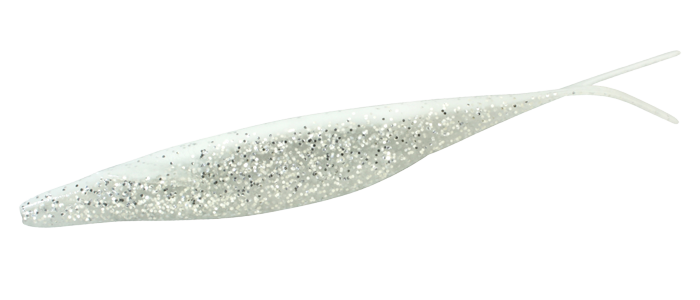
Mid-Strolling the Sakamata Shad - How do you get it to roll so well?
Any fluke-style bait and a regular jighead will work when the fish are overly aggressive, but a more refined approach is needed when trying to coax pressured bass or those in a negative or neutral mood. According to Walker, getting more bites in this situation takes more skill, and he shares his insights on fishing these jighead minnows properly.

The Sakamata Shad: How do you get the bait to roll so well?
There’s a reason the Deps Sakamata Shad has been one of the most sought-after baits in the past few years: they work exceptionally well. The baits are hard to keep in stock as more anglers have discovered how well they work thanks to design features like the molded wings on both sides of the bait, which allow the bait to roll from side to side better than other baits.
Each size of the Sakamata Shad is slightly different in how it acts, and because of its design, it can be relatively easy to get the bait to rock and wobble during the retrieve. Still, one of the most frequently asked questions on videos of the bait is, “How do you get the bait to roll so well?”
According to Walker, several answers exist, the biggest being the conditions, angler experience with the technique, and gear used.
“It takes some time to figure out how to get it to roll perfectly, and I think a lot of anglers maybe give up on it too soon,” he said. “Besides just the bait, there are a lot of factors. Current, wind, and the speed of your boat all play a role in how easy it is to get the right action, and you have to consider all of that; it’s more than just rigging up a bait and shaking your rod to get it to roll.”

Choosing the Right Jighead
Besides old-fashioned practice, the right jighead makes a big difference in getting a controlled roll. Several versions on the market are designed for the technique, and Walker says choosing the right one for each lure and considering the conditions is critical.
When fishing in heavy current or deeper water, Walker understandably goes heavier, but he prefers a lightweight head any other time. “I still always try to use the lightest weight I can get away with to let the bait do the work,” he said. “I use an Owner Range Roller 3/16-ounce head many times, and you’ll always get more side-to-side with a lighter head. It’s not a huge roll, more like a 10 o’clock to a 2 o’clock position. The best action is a natural rolling and not flopping from one side to the other, and that’s easier the lighter you go.”
The hook size of your jighead is also critical, and Walker likes the smallest sizes he can get away with, which allows for more plastic that is not threaded with a hook shank. “Hook size is a big factor as well, and if the hook is too far back into the body of the bait, you take away a lot of that rolling,” he said. “I use the smallest hook I’m comfortable with for the fish I’m targeting.”
Mid-Strolling Gear
Going beyond just the jighead and minnow, choosing the right line and rod can also help obtain the perfect rolling action to catch more bass. It’s a complete system that requires attention to the little details to get the most out of baits like the Sakamata Shad.
With the popularity of this technique, specialty rods have also entered the scene. The Deps Gain Element Shaking Rods are technical rods designed for better action from your baits. They have a soft top to achieve great rolling but a stouter rear section for handling big bass. They’re also much shorter than most modern spinning rods at 6 feet, 5 inches, and 6 feet, 6 inches long for the light and medium-light models, respectively.
No matter what rod you choose, Walker says the length of the rod is critical. “A longer rod is going to pull the bait too much when you’re shaking it,” he said. “You’ll be shaking, and it will move the bait too much, so for me personally, the longest rod I would consider is 7 feet, 2 inches, but I like an even shorter rod a lot of times.”
Some anglers also prefer shorter leaders of heavier-than-normal fluorocarbon for their mid-strolling. On the other hand, Walker uses standard braid and fluorocarbon leader sizes and lengths.
“I keep it pretty simple and use 16 LB Sunline Almight sinking braid and a leader of 7 lb Sunline Sniper fluorocarbon that’s about five feet long, just long enough that it doesn’t go into the reel. The sinking braid helps to control your line better,” he said. “I know everyone’s a little different, and some people like heavier leaders and really jack the fish, but I don’t set the hook; I just reel down and pull back since it’s an open hook. I only go to heavier lines when fishing the 7- or 8-inch Sakamata. I don’t change my line to change the bait’s action like some guys do.”
The mid-strolling technique has been popular in Japan for several years, but it’s still in its infancy in North America. As it continues to gain popularity here, anglers in the know are learning ways to get their baits to roll and perform better by selecting the right gear and mastering the technique.










